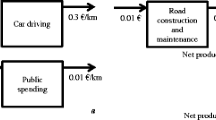Abstract
Background
LCA is the only internationally standardized environmental assessment tool (ISO 14040-43) for product systems, including services and processes. The analysis is done ‘from cradle-to-grave’, i.e. over the whole life cycle. LCA is essentially a comparative method: different systems fulfilling the same function (serving the same purpose) are compared on the basis of a ‘functional unit’ - a quantitative measure of this function or purpose. It is often believed that LCA can be used for judging the (relative) sustainability of product systems. This is only partly true, however, since LCA is restricted to the environmental part of the triad ‘environment/ecology - economy - social aspects (including intergenerational fairness)’ which constitutes sustainability. Standardized assessment tools for the second and the third part are still lacking, but Life Cycle Costing (LCC) seems to be a promising candidate for the economic part. Social Life Cycle Assessment still has to be developed on the basis of known social indicators.
Method and Limitations
LCA is most frequently used for the comparative assessment or optimization analysis of final products. Materials and chemicals are difficult to analyse from cradle-to-grave, since they are used in many, often innumerable product systems, which all would have to be studied in detail to give a complete LCA of a particular material or substance! This complete analysis of a material or chemical is evidently only possible in such cases where one main application exists. But even if one main application does exist, e.g. in the case of surfactants (chemicals) and detergents (final products), the latter may exist in a great abundance of compositions. Therefore, chemicals and materials are better analysed ‘from cradle-to-factory gate’, leaving the analysis of the final product(s), the use phase and the ‘end-of-life’ phases to specific, full LCAs.
Conclusion
A comparative assessment of production processes is possible, if the chemicals (the same is true for materials) produced by different methods have exactly the same properties. In this case, the downstream phases may be considered as a ‘black box’ and left out of the assessment. Such truncated LCAs can be used for environmental comparisons, but less so for the (environmental) optimization analysis of a specific chemical: the phases considered as ‘black box’ and left out may actually be the dominant ones. A sustainability assessment should be performed at the product level and contain the results of LCC and social assessments. Equal and consistent system boundaries will have to be used for these life cycle tools which only together can fulfil the aim of assessing the sustainability of product systems.
Similar content being viewed by others
Author information
Authors and Affiliations
Corresponding author
Rights and permissions
About this article
Cite this article
Klöpffer, W. Life Cycle Assessment as Part of Sustainability Assessment for Chemicals (5 pp). Env Sci Poll Res Int 12, 173–177 (2005). https://doi.org/10.1065/espr2005.04.247
Received:
Accepted:
Published:
Issue Date:
DOI: https://doi.org/10.1065/espr2005.04.247




